This reading “Five Minds for the Future” by Howard Garder breaks down the cognitive abilities that will be developed in the future: the disciplinary mind, the synthesising mind, the creating mind, the respectful mind and the ethical mind.
The disciplinary mind: able to perform certain activity and develop skills over time
The synthesising mind: ability to process and digest information according to particular situation
The creating mind: ability to discover and generate new ideas, problems and solutions
The respectful mind: awareness of their surrounding people and able to emphasise their situation
The ethical mind: awareness of their responsibilities of their roles in the society and the world
I would divide these five minds into two parts, categorise the first three as an interpersonal skill and the last two as a person’s character and personality. The society demands so much nowadays that they wish every new entry levels or fresh graduates to hold all these five minds, which I would say, all-rounder since they both have knowledge, skills and good character. But of course, looking at how globalisation and technology have changed over the years, people get distracted so easily by their personal gadgets. For example, on-line or in-app news start to replace newspapers, and that leads to hundreds of mobile apps while having the same aim as one another: to deliver the news. I would say sooner or later our generation will lack creativity because of the overwhelming information.
“We should be concerned with how to nurture these minds in the younger generation, those who are being educated currently to become the leaders of tomorrow”.
Garder, (2007).
I totally support what Garder had said because fresh graduates are new in the society and the people who are already in the industry or workforce are obviously their seniors. Thus, the seniors should show guidance and support to the younger generation so the society would have more all-rounder youngsters in the workforce who would make a difference one day. I also think that this is important to be part of the education system as well, especially Asian countries schooling system. Students tend to sit in class, listen and copy notes off from the blackboard, and in the end, a majority of the students would be timider to speak up.
Regarding creativity as well, I have seen my 8-year-old young cousin got a zero mark for Moral Studies just because his answers are a bit ‘different’ from the expected answer. The picture showed a young boy holding a drumstick in his sister’s bowl and they were sitting happily together. This was a ‘Describe the Picture’ section. According to the teacher, the answer was supposed to be “My brother is loving. He shares his drumstick with me,” but my cousin wrote “My brother is hungry. He is taking my drumstick away.” I was laughing it off, but the teacher gave my cousin a big cross over the answers. The answer could have been seen as a very creative answer but the teacher said that it was Moral Studies so the answers had to be morally right. My cousin asked for an explanation why couldn’t the brother be hungry, and the teacher just said that was just not the answer. Most of the times, answers are given but not the explanations. This would cause one to lose creativity bit by bit, and send his creativity to death eventually. I hope that the education system would change in the future, focusing on every individual trait of someone, and allow the future generations to have their space to go further towards their interest while not losing their ethical character and attitude.
Garder, H. (2007). Five Minds For The Future. Harvard Business, School Press, Boston.
‘Finding Time in a Digital Age’, the topic of this week’s reading.
This title is so relatable to my daily life that I even feel like reading this and writing a blog post about it will take up 2 hours (bad concentration here) when there are only 24 hours a day (minus 8 hours of sleep, one hour of breakfast and preparation for class, walk to uni and walk back took around half an hour, one and a half hour lunch break, went to buy lunch for half an hour, two hours of tutorial and workshop each and dinner for an hour, so I’m only left with three and a half hours for the day and that still excludes gym and showering time which will take up two hours!) So in conclusion, I’m only left with 90 minutes on my own.
In the chapter, Adam rephrased School’s words saying that Americans have lost track of their daily personal time for their own (Adam, 2014), and I would say most of the working people, in fact, have no control over their time when 9am to 5pm is the basic working hours, one hour to prepare for work and one hour to get back home, with overtime work for like 2 or 3 hours, lunch and dinner time 2 hours, and their day is left with 7 hours, and this 7-hour time has to include their sleeping hours. According to Adam (2014), the standard working time is 8 hours, from Monday to Friday is a “landmark achievement of twentieth-century social democracy” after the World War II. I would argue the same as Robert and Edward Skidelsky that we are performing better as compared to twentieth-century, but why aren’t the work time getting reduced, and especially when technologies have been replacing our positions to get the jobs done?
Talking about technology, it has gradually become one of the essential needs in our lives. Whether at the subway or pedestrian cross or even toilet, you’ll never fail to see anyone who’s without their phone, their tablets. For instance, while waiting for food, someone on the table will be Snapchat-ing, and when the food comes, taking pictures comes before eating, even I do that sometimes when it’s meant to be a bonding time and enjoying-the-food moment. Digital detox diet must come at once, a day in a week is enough…
Instagram moment #1

Instagram moment #2

This week’s reading literally made me think of the reason why I chose to study media. It talks about two types of mindset people have: craftsman mindset and passion mindset, and come to think about it, I’m adopting the craftsman mindset.
Initially, when I graduated from high school, I went to Manchester and planned to study Foundation and Bachelor of Law since UK is well-known for their Law undergraduate course, and I went. Students are meant to write personal statement to 5 different universities at max to apply for the courses that they wanna study, and I applied for Law for all 5 universities (though I don’t know why didn’t I leave a slot for media when I was already having Bachelor of Communication and Media in mind, but I think it’s meant to be). In the end when I finished my foundation, I packed my luggage and flew back to Malaysia without any further planning because that’s how desperate I felt to not to study Law, and now I’m studying Bach of Communication in RMIT. I wouldn’t say I have a craftsman mindset by this, but one thing for sure is that, when I talk about communicating, broadcasting, producing, screenwriting, I feel like I share the same feeling as how Jordan Tice’s eyes lit up when he was trying to share a song that he’s been working on with Calvin Newport, the author of this week’s reading (Newport, 2012).
I hope to see that the current generation will adopt the craftsman mindset more than the passion mindset as according to Newport (2012), passion mindset will lead people to start thinking about what the world would offer you in return if he or she was to do something, and that will gradually make people start to lose the interest and passion in their lives (which is something that I totally agree). Eventually, people will be living on the same pace without challenging tasks, or even just a tiny task will get them feel irritated or frustrated. Whereas adopting a craftsman mindset, a person will think about himself more, and having full attention and passion onto something he is genuinely interested, even though it is an occupation. Confucius once said, “Choose a job you love and you will never have to work a day in your life.” It applies to young people nowadays who are going for higher education (especially in asian families), young kids tend to go for courses that are sort of ‘expected’ rather than something ‘unique’ like filmmaking, sound design and other subjects that are more towards arts and design (in terms of media industry). I would like to shoutout to them that if you really have the passion for it, and that’s what your heart really wants, then go for it. You are the one living your life, not your family, not your friends, not anyone but you. Don’t study or find a job that you know you have no passion in it and you will not enjoy, because life is short.
Reference:
Reference: Cal Newport, 2012, ‘The Clarity of the Craftsman’ in So Good They Can’t Ignore You: Why Skills Trump Passion in the Quest for Work, NY Business Plus, ch.4.
This week’s reading really makes me want to continue to read, it’s like I can forsee my future in this thousands of words. In this chapter, Lobato and Thomas shared that freelance writers work from home, getting paid 1 or 2 cents a word for roughly around 300-400 words passage, and that will be done in 20 minutes time (if efficient enough). So let’s say a writer manage to write a 350-word paragraph that costs 1 cent a word in 20 minutes time, in an hour he will be http://www.mediafactory.org.au/griffin-wong/wp-admin/post-new.phpearning only $10.50 an hour, which is considered as underpaid, and here is the question: is this situation still be considered as a job with flexibility or the employers are just exploiting the freelance writers? Thomas Frank (2010), Harper’s magazine journalist states that this is to be called ‘deprofessionalized journalism’.
I could totally relate to the part where it says that they are people who had been working for nearly a year unpaid in the art and media industry as I have also intern for 3 months during the summer holiday last year without getting paid to gain experience. It’s like young people who have talents and skills are trying to seek for a job that is relevant to what they’re studying and yet due to the lack of experience, they have no choice but to go for internship or voluntary jobs. This will cause the employers to make full use of their skills and talents to complete the tasks when the interns are contributing for free. The pros of this scenario: from the intern’s point of view, he will get more experience in the industry (that’s all); from the employer’s point of view, they are getting unpaid employees who are willing to contribute, and the cons of this scenario: the interns might always be an ‘intern’ only as the employers are not willing to keep them as a full-time employee (since unpaid intern works just the same as full-time employee), and this will increase the rate of unemployment among fresh graduates or young adults.
Jaron Lanier wrote the book Who Owns the Future? (2013) and it started off by saying Kodak the photography company started off strong with a lot of employers and was worth $28 billion but was bankrupt in the end. Also, when Facebook bought over Instagram back in 2012, it was reported that it only hired 13 people, and so he was asking where are all the jobs and how could the company possibly went bankrupcy when those middle-class jobs had contributed to the company (Lobato and Thomas, 2015). I personally think that technology nowadays is so advanced that has caused the unemployment rates to increase as a lot of things can be done online unlike the older days.
As I have read the report, “ A World of Difference” by Chris Lederer and Megan Brownlow, I realised it is true that the spending in entertainment and media industry has been growing rapidly throughout the years.
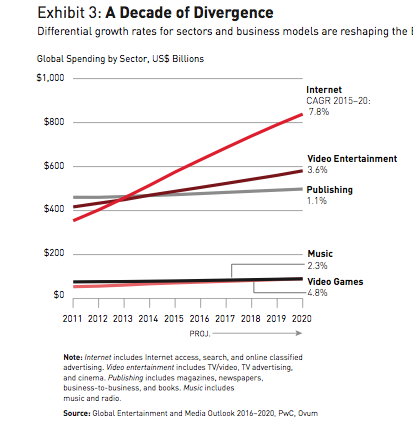 According to the graph above, we can see that Lederer and Brownlow divided into 5 categories: video entertainment (regardless of films or TV shows), publishing, music, video games and internet. As we can see, the spending on Internet has a massive growth as compared to the other four segments. In 2011, the global spending on Internet was like below $400 but it is expected that it will shoot up to more than $800 in 2020, whereas publishing only had like a 1.1% increase in its growth. The Internet has become our of the daily need whether in work, daily chores or entertainment. We have everything on the Internet in the 21st century, for example like e-news or e-magazine. It is environmentally friendly and definitely will cut down a lot of costs and spending for the publishers. I still remembered back in 2011 when I took the subway in Hong Kong, almost everyone had their eyes locked on the phone and reading the news, and a stack of new newspapers was in at the side of the door. This made me realised that sooner or later, the publishing of physical newspaper will be replaced by e-news because of it convenience. With the Internet, we can do everything like streaming movies, checking for information, read the latest news and a lot more. Time saving, environmental saving, and energy saving (in terms of manpower for producing and publishing physical material), so why wouldn’t we choose to surf the Internet?
According to the graph above, we can see that Lederer and Brownlow divided into 5 categories: video entertainment (regardless of films or TV shows), publishing, music, video games and internet. As we can see, the spending on Internet has a massive growth as compared to the other four segments. In 2011, the global spending on Internet was like below $400 but it is expected that it will shoot up to more than $800 in 2020, whereas publishing only had like a 1.1% increase in its growth. The Internet has become our of the daily need whether in work, daily chores or entertainment. We have everything on the Internet in the 21st century, for example like e-news or e-magazine. It is environmentally friendly and definitely will cut down a lot of costs and spending for the publishers. I still remembered back in 2011 when I took the subway in Hong Kong, almost everyone had their eyes locked on the phone and reading the news, and a stack of new newspapers was in at the side of the door. This made me realised that sooner or later, the publishing of physical newspaper will be replaced by e-news because of it convenience. With the Internet, we can do everything like streaming movies, checking for information, read the latest news and a lot more. Time saving, environmental saving, and energy saving (in terms of manpower for producing and publishing physical material), so why wouldn’t we choose to surf the Internet?
Also, content is still the core element to achieve the success. For instance, the highly anticipated film for nearly 2 years, “Batman vs Superman: Dawn of Justice” faced a drastic box-office drop after the first week of its premiere. (Wikipedia, 2016) The reviews were generally negative about its content, like complex plot twists, draggy storyline, humourless and more. Whereas “Zootopia” the animation had grossed a total of $1.023 billion worldwide despite its $150 budget surprisingly. (Wikipedia, The critics reviewed that it has a good character development and strong moral values, and for the change of Disney heroine’s character, she is not focusing on romance or family but rather her dream and her career, which has caused the viewers to relate a lot. Thus, we can see that content really plays a very important role in the E&M industry to help to reach the success.
References:
1. Lederer, C& Brownlow, M 2016, A World of Differences, PwC Network.
After reading “The Fourth Industrial Revolution’ by Klaus Schwab, I truly relate to the part where it says the industries are having an obvious revolution in terms of digitalization and information technology. For instance, when robots were first created, they were considered as a great creation but throughout the years, they evolved from performing only limited tasks to perform daily chores or even nursing, which makes them more adaptive and flexible. Also, for example, like mobile phones, we had black-and-white-screened phones to 2G phones, which contain camera function and mp3 player, and later to touch screen phones like iPhone or Samsung. The change in technology does not only cut down the costs in every aspect but also cuts down the amount of energy used to perform a certain task. On the other hand, robots that are slowly becoming more human-like will cause the increase in unemployment as robots will soon take over human (robots are neither human nor living things, thus they do not need living expenses to keep them surviving, which will cut down a lot of costs for the employer).
I really agree with what Schwab had mentioned in the chapter that the presence of internet had a very strong impact and influence in every industry, especially media industry. All the social medias and web pages can only act as a platform to carry out its tasks with the presence of internet. Just take a look at the tv show The Feed, there may be viewers who have missed out one or two, but with the internet and the social websites performing together, it allows the viewers to watch them online, in a way which also allow them to earn more (a win-win situation). Also, just take a look at media factory blog, without internet, this blog could not act as a platform to allow the tutors and professors to have interaction with the students.

Hot air balloon signifies the start of my day.
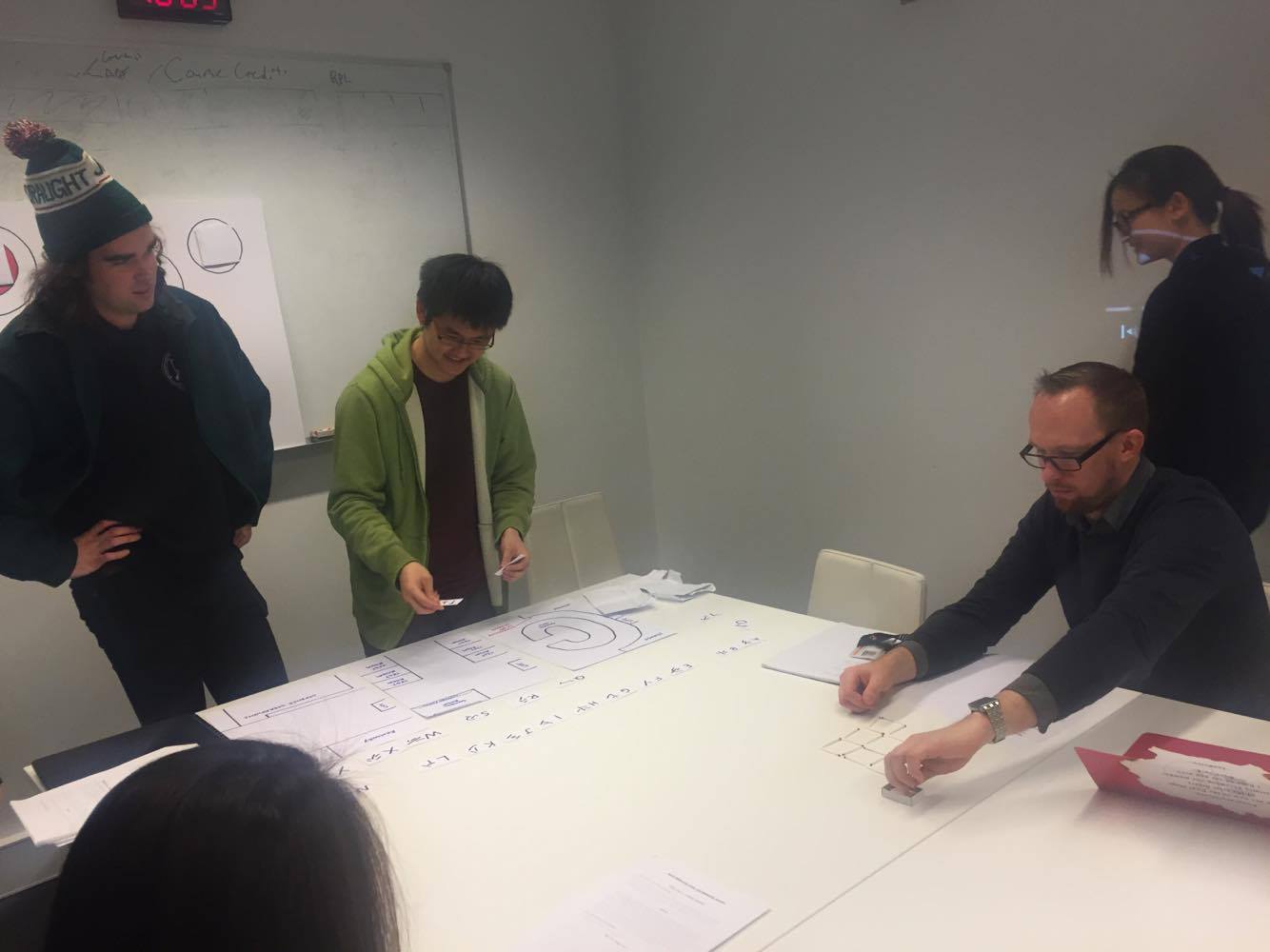
Darren playing Adam the spec ops and Dan playing Isabella the tactician.
We started our game at 9.36 and everything went well. Due to the sudden change of classroom, the limitation of space left us no choice but to narrate out the actions that we were meant to act out. Video logs and audio logs played smoothly without buffering, Stefan’s toy gun worked well and the players understood the game instructions well. If I were to say any disappointmens, I would say the limitation of time that caused the players not able to play the game leisurely, but they did enjoy the game after all, so I guess that’s fair enough. I would say it will turn out amazing if this were to create it in ‘Escape’ that kind of concept, with a room being divided by glass walls, and the players will be playing separately but able to see each other’s progress through the glass walls so they are on the same pace. Also, for the hacker’s labyrinth puzzle, it will be really cool if the labyrinth is created with live forms, and have the player to walk through and discover the codes. Lots of ideas, but due to the room space available, time and budget wise, we carried it out this way. I’m glad 😀
This blog will be the answer to Week 7 mid-semester blog post detailing the role, understanding of the project and its direction, and as the final reflection for the studio.
The narrative of the game goes like this: In the year 2030, the Raath (alien forces) invaded the Earth and war raged on between humanity and the Raath, and later humanity began to understand the battle was undefeatable. To prevent humanity from going totally annihilated, several members were selected to represent human race in order to negotiate a peace treaty between the two races. The Raath accepted and declared the cooperation between human race and the Raath would begin a new era of coexistence, but the real intention behind the signing of peace treaty was to have human as test subjects for the Raath to undergo genetic manipulation and experiment the power of mutated genes for the Raath to have more power to control over the Earth.
There are four main characters in this story: Isabella the tactician, Doctor Kuronoma, Gray the hacker and Adam the Spec ops. [Backstory] Isabella was captured in 2031 by the Raath for their experiments, the year when the agreement of peace treaty between two races had concluded. She was held in for 12 years and met Doctor Kuronoma, who was also captured in 2031 to be part of the Raath’s experiment team. He then started experimenting the usual procedures on her but she was the only one who withstood all the chemicals that were meant to wipe out the human race. Doctor Kuronoma escaped with Isabella but was captured in the end while he was letting Isabella escape.
Game flow: The game will start off with a video log by the Leader welcoming the players, the recruits then will walk into the hall room and introduce themselves and their departments. Each character (Tactician, Hacker and Spec ops) can only be performed by a player, thus, the players will have to decide which character to play upon.
- Isabella: As the tactician, the player is meant to find out the time and schedule of the Raath’s plan and stop them from carrying it out.
- Gray: As the hacker, the player will need to crack into the Raath’s system to decipher their passcodes and figure out the security passwords and codes to get into the base and prevent the Raath from doing anything.
- Adam: As the spec ops, the player will be doing most of the physical acts to figure out the location of the Raath’s operation
Noted that there are three stages and this is currently in the first stage, which is a trial for the players before they can be part of the Raath Rebellion team. (Players will have no time limit at this stage. Questions are allowed and hints will be given to help to crack the puzzles.)
Once the players have selected their preferable character, they will be given with 1st stage puzzles. Completion of stage one will then come after with a congratulatory video log by the leader and stage two puzzles (not necessary to be completed as this stage is the final trial puzzle before accepting the players to be officially a Raath Rebellion member). As the stage two puzzles go on, the leaders of the departments will then leave the room for a mission and Alex (supposedly a ghost character) gets called upon to leave too. Later then a video from the Raath gets played on the screen saying the HQ will soon be blown off. After the Raath’s video, the Leader appears back on screen to inform the players to contact Doctor Kuronoma. The tactician will be finding out what time will the explosives blow off and determine how much time do they have left, the hacker will crack into the system by figuring out the password and the spec ops will figure out the location of the bomb. Doctor Kuronoma acts as the key character as the players will guide him to disarm the bomb by using the walkie talkie that is placed somewhere in the corner of the room. There are two possible endings: if the players manage to solve the final puzzles in time, they can protect the HQ and win; if the players fail to solve the puzzles, they then fail to deactivate the bomb and they lose.
In terms of hints for the last puzzles,the spec ops will be using Raath language to figure out the location with the map they choose in the second stage puzzle (amount of Raath language hints won in first stage puzzle will determine the level of difficulty in the final puzzle). The hacker will be doing sudoku to figure out the password. As for the tactician, the player will receive a box containing Isabella and Doctor Kuronoma’s journals, a pencil, a mirror, and a map of the base, and the player is meant to figure out where the hints are hidden and figure out the time hidden within the box.
We did not use any digital and social media as one of our platforms, instead, we used video logs, audio logs, journal and physical objects like bullet gun to allow the game to be more effectively immersive. We added the idea of ‘agency’ into our game as the players are able to experience the actual feeling tension of time chasing with background sound effects when solving puzzles. I am very happy with my group’s performance as we started out with ideas all over the place, but we managed to merge them together and pulled them off well. Overall, I am glad that I have chosen Story Lab as my studio.
The picture below is the demonstration of the first stage puzzle of the tactician.
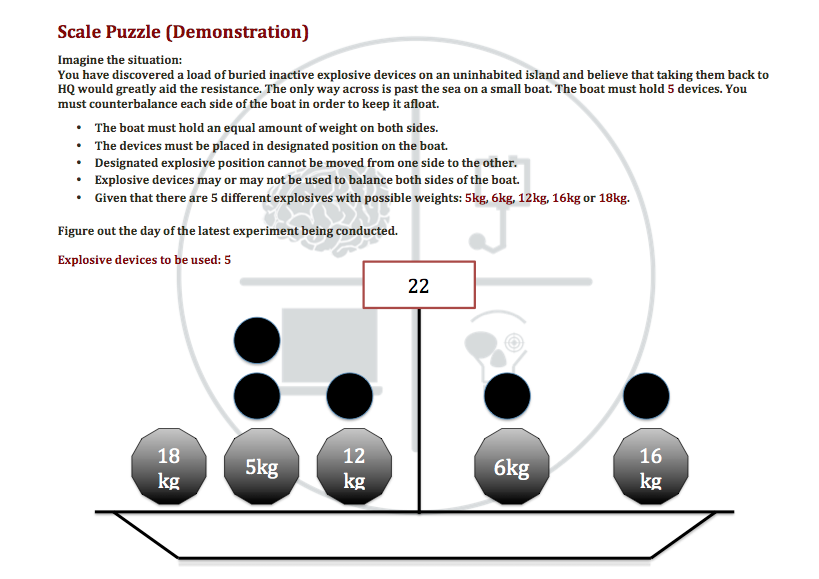
Solve the following puzzle and figure out the DATE of the latest experiment being conducted.
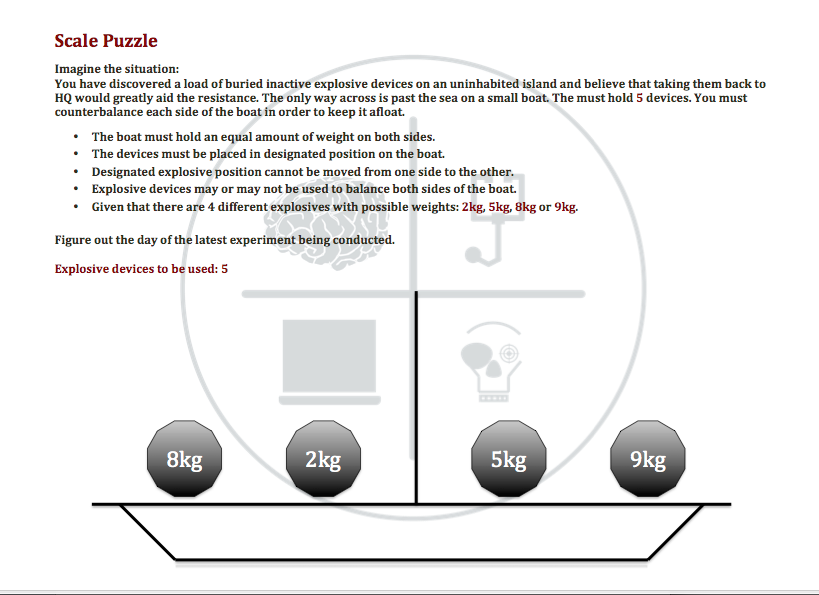
Second stage puzzle: Figure out the DATE of the placement of the bomb.
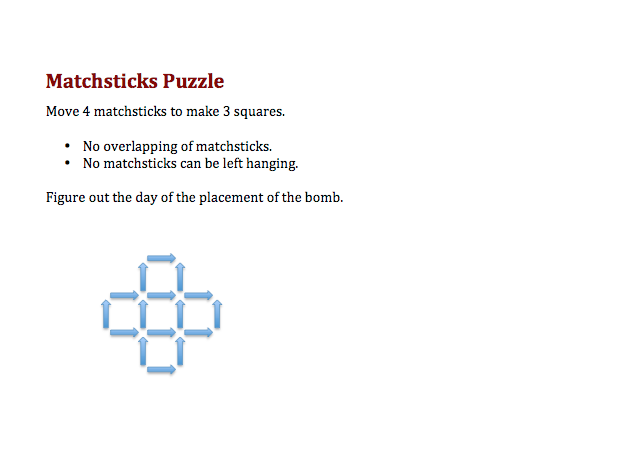
Questions and feedbacks are welcomed. Thank you 🙂
I had a very long day with my groupmates to play out each other’s puzzles. As I was in the uni since early morning, I went back to my apartment to have a short lunch break. Left my phone on silent mode in my bag and didn’t realize Farina called to ask me if I have matchsticks. I didn’t realize until I went back to meet up with them and found out Steven had gone to buy matchsticks when I already got them prepared (feeling very bad here). Wei Yun joined us and solved my matchsticks puzzle together with Steven and Farina (Stefan only joined us a while later as he’s got work shift). It was fun to see them solving the puzzles together and since Wei Yun solved the puzzles first, she gave out hints that were too direct and that actually caused Steven and me to think about the hints even more (though I knew the answer, but her hints literally got me confused LOL). As for Wei Yun’s puzzle, who’s in charged of the character Gray the Hacker, all of us besides Stefan had tried out on Monday.
We moved to a classroom when Stefan joined to rehearse the script and the actual procedures of the game. Not going to spoil the plot (game run is on Friday morning), our game involves video logs, audio logs, journals, shooting toy gun, digital sudoku, and digital labyrinth. Each of us takes a turn to try out Stefan’s first level puzzle since we’ve already done Wei Yun’s and mine (as according to the game flow). After completing the first stage, we then moved on to the second and last stage. We were trying to change the hints for the last puzzle of mine to make them clearer as the hints may seem hard to be relatable.
Puzzle of the day.









